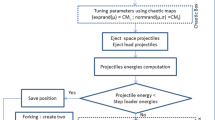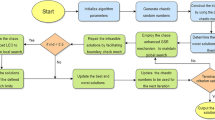Abstract
In the present paper, we propose a new multipoint type global optimization model using a chaotic dynamic model and a synchronization phenomenon in nonlinear dynamic systems for a continuously differentiable optimization problem. We first improve the Discrete Gradient Chaos Model (DGCM), which drives each search point’s autonomous movement, based on theoretical analysis. We then derive a new coupling structure called PD type coupling in order to obtain stable synchronization of all search points with the chaotic dynamic model in a discrete time system. Finally, we propose a new multipoint type global optimization model, in which each search point moves autonomously by improved DGCM and their trajectories are synchronized to elite search points by the PD type coupling model. The proposed model properly achieves diversification and intensification, which are reported to be important strategies for global optimization in the Meta-heuristics research field. Through application to proper benchmark problems [Liang et al. Novel composition test functions for numerical global optimization. In: Proceedings of Swarm Intelligence Symposium, 2005 (SIS 2005), pp. 68–75 (2005); Liang et al. Nat. Comput. 5(1), 83–96, 2006] (in which the drawbacks of typical benchmark problems are improved) with 100 or 1000 variables, we confirm that the proposed model is more effective than other gradient-based methods.
Similar content being viewed by others
References
Aihara K., Takabe T. and Toyoda M. (1990). Chaotic neural networks. Phys. Lett. A. 144(6–7): 333–340
Tokuda I., Onodera K., Tokunaga R., Aihara K. and Nagashima T. (1998). Global bifurcation scenario for chaotic dynamic systems that solve optimization problems and analysis of their optimization capability. Electron. Commun. Japan (Part III: Fund. Electron. Sci.) 81(2): 1–12
Masuda, K., Aiyoshi, E.: Global optimization method using chaos of discrete gradient dynamics. In: Proceedings of IFAC Workshops ALCOSP and PSYCO 2004, pp. 825–830 (2004)
Mizukami M., Hirano M. and Shinjo K. (2001). Simultaneous alignment of multiple optical axes in a multistage optical system using Hamiltonian algorithm. Opt. Eng. 40(3): 448–454
Glover F. and Laguna M. (1997). Tabu search. Kluwer Academic Publishers, The Netherlands
Goldberg D.E. (1989). Genetic algorithms in search, optimization and machine learning. Addison-Wesley, USA
Kennedy, J., Eberhart, R.C.: Particle swarm optimization. In: Proceedings of IEEE Int. Conf. Neural Networks, pp. 1942–1948 (1995)
Chao J., Ratanaswan W. and Tsujii S. (1990). A new global optimization method and supervised learning of multilayer neural networks. IEICE Trans. E 73(11): 1796–1799
Fujisaka H. and Yamada T. (1983). Stability theory of synchronized motion in coupled-oscillator systems. Progr. Theor. Phys. 69(1): 32–47
Fujisaka H. and Yamada T. (1983). Stability theory of synchronized motion in coupled-oscillator systems. II. Progr. Theor. Phys. 70(5): 1240–1248
Liang, J.J., Suganthan, P.N., Deb, K.: Novel composition test functions for numerical global optimization. In: Proceedings of Swarm Intelligence Symposium, 2005 (SIS 2005), pp. 68–75 (2005)
Liang J., Baskar S., Suganthan P. and Qin A. (2006). Performance evaluation of multiagent genetic algorithm. Nat. Comput. 5(1): 83–96
Griewank A., Juedes D. and Utke J. (1996). Algorithm 755; ADOL-C: a package for the automatic differentiation of algorithms written in C/C. ACM Trans. Mathemat. Software. 22(2): 131–167
Walther, A., Griewank, A.: ADOL-C 1.10.1. http://www.math.tu-dresden.de/∼adol-c/. Cited 16 Apr 2006 (Last Modified in 2005)
Barhen J. (1997). TRUST: A deterministic algorithm for global optimization. Science 276(5315): 1094–1097
Yiu K.F.C., Liu Y. and Teo K.L. (2004). A hybrid descent method for global optimization. J. Global Optimiz. 28(2): 229–238
Wang, Y.J., Zhang, J.S., Zhang, Y.F.: A fast hybrid algorithm for global optimization. In: Proceedings of Machine Learning and Cybernetics, 2005, pp. 3030–3035 (2005)
Parsopoulos K.E. and Vrahatis M.N. (2004). On the computation of all global minimizers through particle swarm optimization. IEEE Trans. Evol. Comput. 8(3): 211–224
Sakuma, J., Kobayashi, S.: Extrapolation-directed crossover for real-coded GA: overcomingdeceptive phenomena by extrapolative search. In: Proceedings of IEEE Congress on Evolutionary Computation, 2001 (CEC2001), pp. 655–662 (2001)
Armijo L. (1966). Minimization of functions having Lipschitz continuous first partial derivatives. Pacific J. Mathemat. 16(1): 1–3
Levy A.V. and Montalvo A. (1985). The tunneling algorithm for the global minimization of functions. SIAM J. Sci. Stat. Comput. 6(1): 15–29
Griewank A.O. (1981). Generalized descent for global optimization. JOTA. 34(1): 11–39
Rosenbrock H.H. (1960). An automatic method for finding the greatest or least value of a function. Comp. J. 3(3): 175–184
Yasuda, K., Iwasaki, N.: Adaptive particle swarm optimization using velocity information of swarm. In: Proceedings of IEEE Int. Conf. on Systems, Man, and Cybernetics, 2004, pp. 3475–3481 (2004)
Rastrigin L.A. (1974). Systems of extremal control. Nauka, Moscow
Author information
Authors and Affiliations
Corresponding author
Rights and permissions
About this article
Cite this article
Okamoto, T., Aiyoshi, E. Global optimization using a synchronization of multiple search Points autonomously driven by a chaotic dynamic model. J Glob Optim 41, 219–244 (2008). https://doi.org/10.1007/s10898-007-9222-5
Received:
Accepted:
Published:
Issue Date:
DOI: https://doi.org/10.1007/s10898-007-9222-5




